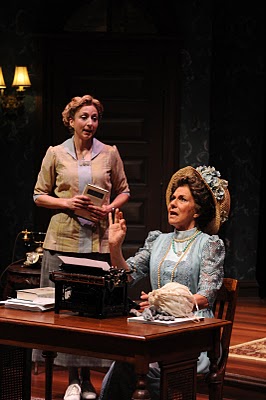The Norman Conquests (Acorn Media, three discs). Now on DVD for the first time, the 1977 TV version of Alan Ayckbourn’s trilogy of interlocking comedies about hanky-panky at a country house, starring Penelope Keith and Tom Conti and directed by Herbert Wise. If you missed the Broadway revival of this darkly funny masterpiece, make haste to catch up in the comfort of your living room (TT).
Archives for 2011
CD
Modern Jazz Quartet, The Quintessence (Fremeaux & Associés, two CDs). An exceptionally well-chosen anthology of classic MJQ recordings made between 1952 and 1960, imported from France and worth every penny. If you’re in need of an introduction to one of the great working jazz groups of the postwar era, this one will do the job with plenty of room to spare (TT).
DVD
John Gielgud, Ages of Man (Entertainment One). Courtesy of the Archive of American Television, the 1966 broadcast version of the great actor’s one-man Shakespeare show, which aired on CBS on two consecutive Sunday afternoons (the network suits didn’t think anybody would sit still long enough to watch the whole show in one go) and has been in limbo ever since. Contemporary Shakespeare style has changed beyond recognition since Gielgud’s day, but his elegant delivery and exquisitely modulated voice remain as seductive–and intelligent–as ever (TT).
PLAY
Who’s Afraid of Virginia Woolf? (Steppenwolf Theatre Company, Arena Stage, Washington, D.C., closes Apr. 10). Tracy Letts, the author of August: Osage County, stars in the Steppenwolf Theatre Company’s stunningly direct and unadorned production of Edward Albee’s best play, backed up by a perfect ensemble cast and directed with precision and simplicity by Pam MacKinnon. I saw it a week too late to cram it into my best-of-the-year list, but you can be it’ll be there come 2011 (TT).
TT: If you’re in need of good cheer today…
…this will do the job:
TT: Tremors
 I know all about natural disasters—up to a point. The New Madrid fault runs through the small Missouri town where I grew up, and I spent many a nervous evening in the basement of our house when I was a boy, listening to tornado warnings on a transistor radio. Still, it’s been my good fortune never to be physically present when the sky fell or the earth shook.
I know all about natural disasters—up to a point. The New Madrid fault runs through the small Missouri town where I grew up, and I spent many a nervous evening in the basement of our house when I was a boy, listening to tornado warnings on a transistor radio. Still, it’s been my good fortune never to be physically present when the sky fell or the earth shook.
Perhaps for this reason, I always feel a special kinship with those whose luck has run out. I was, for instance, transfixed by Hurricane Katrina, so much so that Our Girl and I temporarily turned this blog into a clearinghouse of links to Web-wide blog-based reports about the hurricane and its aftermath. Our improvised “stormblog” was one of the first such ventures to be undertaken in the youthful days of blogging, and it astonished us to be told after the fact that we’d written ourselves into the history of a new medium.
Now that the Web has grown up, of course, such homespun efforts have become quaint. Like the rest of the world, I’m using Twitter to keep up with breaking news from Japan, Hawaii, and the West Coast. But as I read the latest reports of the growing devastation, I thought of the only earthquake I’ve ever experienced. It took place early on a summer morning some twenty years ago, back when I was living in a hilltop apartment in Bronxville, a suburb not far north of New York City. I didn’t have an air conditioner, so the windows were flung wide to the breeze. I was awakened by a slight jerk and a strange noise that I suppose in retrospect must have been the creaking of the building’s skeleton. It was over in a moment. I jumped out of bed, looked around, and heard a second, even stranger noise: the leaves on the trees that surrounded the building were all fluttering at once. I still remember with the utmost vividness the thought that flashed through my mind: It’s a car bomb.
It says something ugly and revealing about the world in which we live today that a man born a stone’s throw from the New Madrid fault should have jumped reflexively to such a conclusion about a tremor in the earth. And it makes me wonder whether there might possibly be some utility in being reminded from time to time that nature needs no help from humankind to wreak havoc in the blinking of an eye.
Things are in the saddle,/And run mankind, Ralph Waldo Emerson famously claimed, but that which runs things also runs us, and eventually it runs us into the ground. “Sooner or later you’re either going to be a caregiver or a caregetter,” a friend of mine told me last night over a glass of wine. That is a sobering thought, reassuring only in the unforgiving way that hard truths give cold consolation. But there is comfort in it nonetheless, just as there is comfort—if only of a bleak and chilly sort—in the undeniable fact that while bombs are made by fools like us, only Mother Nature can make an earthquake. May it always be so.
UPDATE: It now seems that humankind has found a way to heighten the havoc of an earthquake. No matter how strong your sense of irony may be, life will usually find a way to top it.
* * *
A Seventies TV commercial for Chiffon margarine:
TT: Her master’s voice
In today’s Wall Street Journal I review Florida Stage’s regional premiere production of Michael Hollinger’s Ghost-Writer. Here’s an excerpt.
* * *
Theodora Bosanquet is one of those fascinatingly unimportant people privileged by chance to play a choice walk-on part in the history of literature. In 1896 Henry James developed a case of writer’s cramp so severe that he was forced to start dictating his novels to a typist, a practice that he continued to the end of his life. Bosanquet, the last of James’ secretaries, was a brisk, bright young woman with literary ambitions of her own (she became a critic) who published an illuminating memoir called “Henry James at Work” in which she told what it was like to take dictation from a great writer. While there was no question of her being romantically attracted to James–she appears to have preferred women–Bosanquet was clearly obsessed with him, so much so that she later claimed that he continued to dictate to her after he died.
 So curious a creature could scarcely help but attract the posthumous attention of other writers of fiction, among them David Lodge and Cynthia Ozick. Now Michael Hollinger has joined their ranks, using Bosanquet’s obsession with James as the inspiration for a three-character play called “Ghost-Writer” that was first performed by Philadelphia’s Arden Theatre Company in September and has just received its regional premiere in West Palm Beach….
So curious a creature could scarcely help but attract the posthumous attention of other writers of fiction, among them David Lodge and Cynthia Ozick. Now Michael Hollinger has joined their ranks, using Bosanquet’s obsession with James as the inspiration for a three-character play called “Ghost-Writer” that was first performed by Philadelphia’s Arden Theatre Company in September and has just received its regional premiere in West Palm Beach….
“Ghost-Writer” is set in Manhattan in 1919, and Bosanquet’s fictional counterpart is Myra Babbage (Kate Eastwood Norris), a typist who takes dictation from Franklin Woolsey (J. Fred Shiffman), a haughty, unhappily married novelist with a deeply buried romantic streak. Though the high-strung Myra has a beau of her own, she is a young woman of sensibility and so, not at all surprisingly, falls head over heels in love with Woolsey. The play begins shortly after his death, and we learn at the outset that Myra is fending off reporters. Why? Because it seems that Woolsey left behind the manuscript of an unfinished novel–and that Myra is finishing it, allegedly taking dictation from her deceased employer….
Those who are familiar with Henry James’ ghost stories will see at once that this is a quintessentially Jamesian situation, so much so that one wonders why it never occurred to him to write about it. It is no insult to Mr. Hollinger to say that his handling of the situation is more conventional than anything that James would have been likely to write. (The denouement of “Ghost-Writer” is, in fact, reminiscent of Somerset Maugham, a no-nonsense writer who had no use for James’ involuted ambiguities.) Still, that doesn’t keep him from spinning an absorbing tale, or from putting words into Myra’s mouth that are occasionally worthy of the master himself…
* * *
Read the whole thing here.
TT: Almanac
“Musicals continue to be the only art form, popular or otherwise, that is publicly criticized by illiterates.”
Stephen Sondheim, Finishing the Hat
